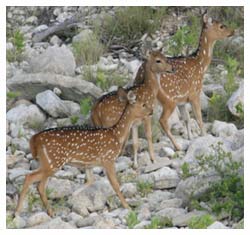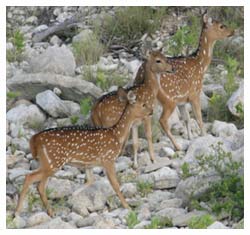Hunting Tips, Questions, Stories & Discussion
Focusing on managing Texas wildlife habitat and natural resources for native and exotic wild game species, for this and future generation of hunters and outdoor enthusiasts.Thursday, January 14, 2010
A Classic Texas Hill Country Axis Hunt!
My target of choice was the elusive aoudad sheep. Since several groups of these animals were spotted at Escondido Ranch earlier in the week, and with one being taken the prior morning, I was optimistic.
Given the prevailing wind, the best spot for seeing a group of aoudad this morning was near Ledge Blind, so called because of its proximity to an edge of a canyon. This ground blind can easily accommodate up to three hunters and its location makes it ideal for hunting everything from axis deer, to aoudad sheep, feral hogs and whitetail deer.
Once I got into the blind, settled in and chambered my .270 rifle, I eased back into a chair and waited. The sun began its ritual morning path and the feeder went off right on cue. Moments later, I spotted three mature whitetail does cautiously surveying the area from along the edge of the brush line. Although the season for whitetail does and whitetail spikes was still open, I could not see a good reason to ruin my chances at an aoudad by prematurely taking a whitetail doe. As the animals finally began to approach the feeder, the wind began to shift unfavorably. Being on the ground and in close proximity to these already weary animals, a whiff of an unfamiliar scent was enough to send the does pouncing back into the safety of the brush. I waited a few more minutes, but decided that given the change in the wind’s direction, it would be prudent to change my location. I grabbed my gun and a pair of binoculars, and started making my way down to the edge of Central Canyon towards the Ambush Blind.
Quietly weaving my way through the trees along a rocky, gravel covered slope, I came upon a large group of Rio Grande turkey hens. These birds were casually making their way through the underbrush even though I was standing no more than 15 yards from the nearest bird. In an effort not to disturb their progress and avoid scarring off any game which maybe grazing down in the canyon, I came to a stand-still hoping that the turkeys would pass…
After several minutes of resembling a statue, it became apparent that the turkeys were not in any hurry. While several of the closer hens kept looking in my direction, the rest of the flock kept picking at the semi-frozen ground and moving along at “a pace of a dying turtle”. I was already cold, so before I became permanently statuesque, I decided to try to move around the flock…huh, that did not work out. As soon as I made the first step, all hell broke loose! The turkeys noisily surged in all directions and up into the trees. The rustling of wings and auditory alarms were almost deafening in the morning’s quiet.
With a big sigh and a few select words, I proceeded down to the Ambush blind. Once I got down to the edge of the canyon near the blind, I surveyed the valley below. It was no big surprise that nothing was moving.
 I settled into a chair and closed my eyes. Not that I would not have enjoyed a few minutes of shut-eye, but the shape of this narrow canyon carried sounds so well that you could actually hear the animals moving before you could even see them. I listened for a few minutes and could only hear the chirping of the birds and distant squawking of turkeys. It was already edging past 8:40 am when I heard movement to my left. From the corner of my eye I saw three axis does make their way across the road, pausing for a bit and then disappearing into the brush on the other side. Although, at that point, I could no longer see the animals, I could clearly hear them making their way up the face of the canyon, opposite of my location.
I settled into a chair and closed my eyes. Not that I would not have enjoyed a few minutes of shut-eye, but the shape of this narrow canyon carried sounds so well that you could actually hear the animals moving before you could even see them. I listened for a few minutes and could only hear the chirping of the birds and distant squawking of turkeys. It was already edging past 8:40 am when I heard movement to my left. From the corner of my eye I saw three axis does make their way across the road, pausing for a bit and then disappearing into the brush on the other side. Although, at that point, I could no longer see the animals, I could clearly hear them making their way up the face of the canyon, opposite of my location.I knew that one of the guest hunters was interested in harvesting an axis doe, so I text him my whereabouts. While I awaited for a reply, I continued to scan the opposite side of the canyon for movement. As the rising sun illuminated the west side of the canyon, my side remained in the shadows. As the animals worked their way up the slope, they paused in clearings to bathe in the sunlight, which gave me the opportunity to see the axis while I remained unseen by them. Then the sudden vibration of my phone from the incoming message startled me. The text simply said “shoot one”.
A smile probably lit up my face. I reached for the gun. Spotting an axis about 250 feet up the canyon’s face and 170 yards away, I brought the scope to my eye and traced an upward path from the base of the slope. As I zoomed in, it became apparent that I was looking at a young axis buck (or a spike). I pulled away from the scope and gazed across the canyon wall. I could see nothing else in the few gravel covered spaces along the face. I leaned back towards the scope and reacquired the axis buck as it was moving along the ledge. It was then I spotted a partially hidden axis doe trailing the spike. Allowing the axis doe to clear the cover and step into the opening, I placed the cross-hairs behind the shoulder, removed the safety and squeezed… “BOOM” rang out and echoed back along the canyon’s walls.
Before the rising gun smoke obscured my line-of-sight, I could see the projectile’s impact as the stiffened animal toppled over to its side and slid several feet down before getting caught up in some vegetation. It was then that the opposite side of the canyon irrupted with movement, as 8 to 10 axis deer dashed from beneath the brush and over the top ridge of the canyon. Great camo! Even armed with 16x binoculars, it was impossible to spot the axis deer in the cover.
Giddy as a schoolboy, I picked up the cell and informed the other hunter that “dinner was served”. But before we could throw the back straps on the grill, someone would have to climb up the cliff to retreat the axis doe. A quick plan was devised; I was to stay put on my perch and direct the recovery crew to the place where the animal would have landed.
Within a few minutes of their arrival, a two men team successfully ascended the slope and recovered the deer. However, while on the way down I could not help but to overhear them complaining about me shooting animals too high up the cliff..., that I should really try to knock the animals off so that they simply slide down to the base… and next time, I should climb up and get them myself… Like I stated before, there are great acoustics in that canyon. Besides, they were just jealous!
Later, the two hunters thanked each other…one for the venison, and the other for an opportunity to make a memorable shot. Although my aoudad was still lurking in the shadows of Escondido Ranch terrain, this was a classic and no-less successful Texas Hill Country axis deer hunt!
Labels: axis doe hunting, texas aoudad hunts, texas axis deer hunts
Monday, June 29, 2009
What is the best way to prepare Texas Axis deer?
Regardless of how you choose to prepare Texas Axis deer meat is it important to not overcook this meat. It is best served medium to medium well, but never cooked all the way to well done. Well done venison is going to be both dry and tough, much more so than well done beef. This is largely due to the minimal fat and lack of marbling or distribution of fat through the lean muscle  tissue. Domestic animals have been bred to have fat and marbling while wild species are naturally lean and low fat.
tissue. Domestic animals have been bred to have fat and marbling while wild species are naturally lean and low fat.
What natural terrain is most favorable for hunting Texas Axis deer?
The Texas Axis deer is able to use their coloration to blend into the surroundings, especially around their favorite feeding locations. They tend to be found in the early morning and at dusk along the edge of wooden area, grazing out into open spaces. The background of the trees and wooded areas blends very well with their various shades of brown coats and the white spots further create a blending effect.
Since the nature preference for these deer is the wooded areas, feeders are typically placed just inside a clearing or along the inside edge of an opening. This natural placement of feeders encourages the natural behavior of the Texas Axis deer, but also draws them more into the open so hunters have a clearer line of sight for a shot.
Do the antlers of a Texas Axis deer grow each year or are they constantly on the bucks?
Like most deer, the Texas Axis deer bucks lose their antlers every year, according to when they were born. Every year the small buds, more specifically known as pedicels, start to grow in the spring, producing the first signs of antlers. These antlers are covered in velvet, which is rich in blood to nourish the growing cells within the antlers. When the antlers reach full size, which will vary from buck to buck, the blood supply is cut off due to hormonal changes as the rut approaches. This decrease in blood to the antlers causes the velvet to dry and the bucks rub their antlers against trees, rocks or shrubs to rid them of the old velvet.
At this point the antlers are in the best possible condition for a trophy mount. If the buck is not harvested over that season, in the winter the lack of blood to the antlers will result in a weakening of the bone structure at the skull, causing the antlers to actually fall off and the cycle to start again.
Labels: axis deer recipes, axis doe hunting, texas axis deer
Archives
December 2008 January 2009 February 2009 April 2009 May 2009 June 2009 July 2009 August 2009 September 2009 November 2009 December 2009 January 2010 February 2010 March 2010 April 2010
Subscribe to Posts [Atom]
